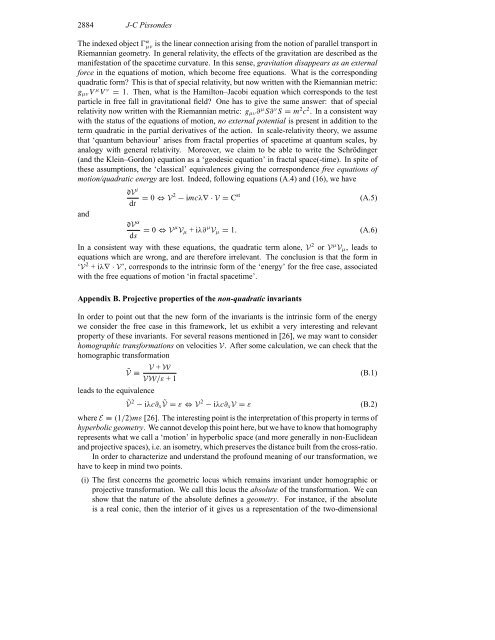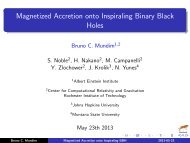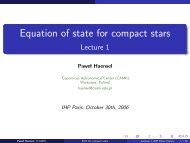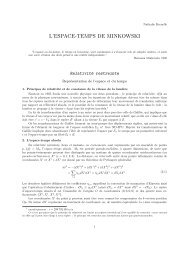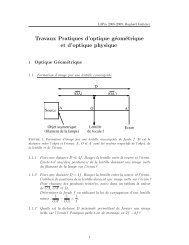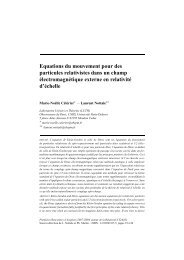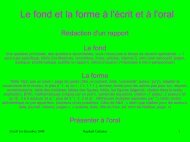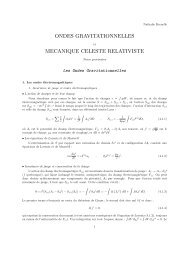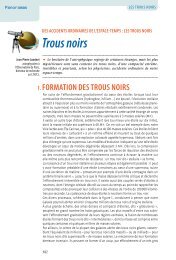J. Phys. A: Math. Gen. 32 (1999) - LUTH - Observatoire de Paris
J. Phys. A: Math. Gen. 32 (1999) - LUTH - Observatoire de Paris
J. Phys. A: Math. Gen. 32 (1999) - LUTH - Observatoire de Paris
You also want an ePaper? Increase the reach of your titles
YUMPU automatically turns print PDFs into web optimized ePapers that Google loves.
2884 J-C Pisson<strong>de</strong>s<br />
The in<strong>de</strong>xed object Ɣα µν is the linear connection arising from the notion of parallel transport in<br />
Riemannian geometry. In general relativity, the effects of the gravitation are <strong>de</strong>scribed as the<br />
manifestation of the spacetime curvature. In this sense, gravitation disappears as an external<br />
force in the equations of motion, which become free equations. What is the corresponding<br />
quadratic form? This is that of special relativity, but now written with the Riemannian metric:<br />
gµνV µ V ν = 1. Then, what is the Hamilton–Jacobi equation which corresponds to the test<br />
particle in free fall in gravitational field? One has to give the same answer: that of special<br />
relativity now written with the Riemannian metric: gµν∂ µ S∂νS = m2c2 . In a consistent way<br />
with the status of the equations of motion, no external potential is present in addition to the<br />
term quadratic in the partial <strong>de</strong>rivatives of the action. In scale-relativity theory, we assume<br />
that ‘quantum behaviour’ arises from fractal properties of spacetime at quantum scales, by<br />
analogy with general relativity. Moreover, we claim to be able to write the Schrödinger<br />
(and the Klein–Gordon) equation as a ‘geo<strong>de</strong>sic equation’ in fractal space(-time). In spite of<br />
these assumptions, the ‘classical’ equivalences giving the correspon<strong>de</strong>nce free equations of<br />
motion/quadratic energy are lost. In<strong>de</strong>ed, following equations (A.4) and (16), we have<br />
and<br />
dV i<br />
dt = 0 ⇔ V2 − imcλ∇ ·V=C st<br />
(A.5)<br />
dVα ds = 0 ⇔ Vµ Vµ +iλ∂ µ Vµ = 1. (A.6)<br />
In a consistent way with these equations, the quadratic term alone, V2 or V µ Vµ, leads to<br />
equations which are wrong, and are therefore irrelevant. The conclusion is that the form in<br />
‘V2 +iλ∇·V’, corresponds to the intrinsic form of the ‘energy’ for the free case, associated<br />
with the free equations of motion ‘in fractal spacetime’.<br />
Appendix B. Projective properties of the non-quadratic invariants<br />
In or<strong>de</strong>r to point out that the new form of the invariants is the intrinsic form of the energy<br />
we consi<strong>de</strong>r the free case in this framework, let us exhibit a very interesting and relevant<br />
property of these invariants. For several reasons mentioned in [26], we may want to consi<strong>de</strong>r<br />
homographic transformations on velocities V. After some calculation, we can check that the<br />
homographic transformation<br />
V + W<br />
˜V ≡ (B.1)<br />
VW/ε +1<br />
leads to the equivalence<br />
˜V 2 − iλc∂x ˜V = ε ⇔ V 2 − iλc∂xV = ε (B.2)<br />
where E ≡ (1/2)mε [26]. The interesting point is the interpretation of this property in terms of<br />
hyperbolic geometry. We cannot <strong>de</strong>velop this point here, but we have to know that homography<br />
represents what we call a ‘motion’ in hyperbolic space (and more generally in non-Eucli<strong>de</strong>an<br />
and projective spaces), i.e. an isometry, which preserves the distance built from the cross-ratio.<br />
In or<strong>de</strong>r to characterize and un<strong>de</strong>rstand the profound meaning of our transformation, we<br />
have to keep in mind two points.<br />
(i) The first concerns the geometric locus which remains invariant un<strong>de</strong>r homographic or<br />
projective transformation. We call this locus the absolute of the transformation. We can<br />
show that the nature of the absolute <strong>de</strong>fines a geometry. For instance, if the absolute<br />
is a real conic, then the interior of it gives us a representation of the two-dimensional


